Breathwork: Techniques to Reduce Stress & Improve Cognition
Breath Tips & Models to Calm Yourself (Even if You’ve Given Up on Meditation!) with Josh Trent
We live in a stressful era. Could something as simple as changing your breathing help? The practice of breathwork can not only reduce your stress, it can also improve your memory, lower your body’s fear response, and make you more cognitively effective. There are many modes of breathwork. In this episode, Josh Trent takes us through the powerful benefits, and some simple steps that beginners can try right away. He also discusses the promise of more advanced methods. If you’ve tried meditation and couldn’t stop your brain, breathwork might be an easier practice for you to adopt.
Best position for breathing/meditating
- Body position before meditating
- Pull shoulders back
- Knees 1-2 inches below your hips
- Spine stacked
- Sit on a meditation pillow or cushion
Breathing techniques
- Warrior breath – see infographic in the transcript below
- Box Breath – see infographic in the transcript below
- 2-7-8 breathing – see infographic in the transcript below
- Journey Breath – see infographic in the transcript below
Research supporting breathwork
Rhythm of Breathing Affects Memory and Fear
- Breathing affects memory and fear
Effects of Nasal or Oral Breathing on Anaerobic Power Output and Metabolic Responses
- Nasal breathing to increase fitness
Where to learn more about Josh Trent
- 7-day breathwork guide – wellnessforce.com/m21
- Breathwork.io – guided journey
In This Episode
Episode Intro … 00:00:40
More Accessible than Meditation? … 00:04:17
Benefits of Breathwork … 00:08:29
Starter Techniques in Breathwork … 00:12:07
The Value of Hypoxia in Breathwork … 00:21:44
Three Recommended Modes of Breathwork … 00:25:38
Seven-Day Breathwork Guide … 00:33:25
Breathwork & Fitness … 00:34:42
Breathwork for Cognition & Presence … 00:36:04
Episode Wrap-up … 00:43:30

Download this Episode (right click link and ‘Save As’)
Episode Intro
Dr. Michael Ruscio, DC: Hi everyone. Welcome to Dr. Ruscio Radio. This is Dr. Ruscio. Today I’m here with my good friend Josh Trent, who is going to talk with us about breathwork, which I think is not as appreciated as it should be. And Josh is really living proof of that. I didn’t know this about Josh. I know Josh as a guy who is always calm and always centered. When we typically interface, we are at Paleo f(x) or other conferences. There are lots of people around. There are lots of pressures. There’s a lot going on. It’s very easy to get a little bit flustered in this type of situation, and every time you look over at Josh, he’s just level, steady, and centered.
I didn’t know this, but Josh has a history of anxiety. He’s been able to go from one end of the spectrum to the other. That’s why I find it so powerful that breathwork has been one of the few things that have been very helpful. Because you weren’t someone who was given this genetic disposition to be really relaxed. You actually figured out how to maneuver some of the dials in your head, so as to lead yourself to a more calm and relaxed way of being. So Josh, super happy to have this conversation and enlighten our audience on the power of breathwork. Welcome.
Josh Trent: Yes. Thank you, man. Thanks for having me. I always enjoy our conversations. And by the way, I appreciate that you say I’m grounded, because what’s on the outside isn’t always what’s on the inside!
DrMR: Like a duck swimming in the pond, and on the surface you look calm, but your legs are kicking underneath?
JT: Yeah, something like that. We all deal with this, right? This shared human experience.
All of us, at some point in our lives, start to notice, “Hmm, am I making this harder than it actually is?” And typically whenever things are challenging in our life, it’s because we’re holding our breath. It’s this big lever, the only autonomic lever we can pull when it comes to the nervous system. That’s it. We can’t digest our own food. Our body does that. We can’t beat our own heart. Our body does that. We don’t control the efferent and afferent signals in our system. Our body does that. But one lever we can pull, Michael, is this breath lever. And we know—you’ve talked about this on the show a whole bunch—the sympathetic and parasympathetic nervous systems are literally the Geiger counter that goes between fight or flight and rest and digest.

So in my life, this breathwork element has been such a huge learning curve. It’s actually tattooed on my arm in Italian. Se posso respirare posso scegliere, which means if I can breathe, I can choose. The reason I got that on there is because in 2016, 2017 I was about to do this SEALFIT event. So for the people that do CrossFit or know about Mark Divine and SEALFIT, I was about to go to this 14-hour Crucible Navy SEAL event. I’m talking overnight, they spray you with water, you’re doing pushups, you’re doing Murph with a weighted vest. Just craziness. And I wanted to do it because I wanted to learn about myself. Looking back, I got this tattoo because I wanted to remind myself to breathe.
Because if we can remember to breathe—before a business meeting, we go on a stage, we’re talking to our spouse about something that’s vulnerable, or just stress in general—if we can train our conscious minds to drop into a specific style of breathwork (typically it involves the mouth closed, breathing in through the nose, with a slow exhale, there are many different modes we’re going to talk about) and practice that in life, the results are palpable, tangible. It’s something that can help everyone. And you know what, Mike? Breathing is free. So I’m really stoked to talk about this, man.
More Accessible Than Meditation?
DrMR: And I also think that there’s an area of fruitful conversation here: for some people who haven’t gotten on board with meditation, they may like breathwork a little bit better. And one of the things you might say I’ve meandered into with my excursions into meditation is really liking to fool around with different breathing patterns. Sometimes I’ll take these very, very deep breaths. They feel very energizing, and I’ll go through a few minutes of maybe a pseudo Wim Hof breathing, even though I don’t know the exact Wim Hof technique. But very, very deep breaths that really open me up, invigorate me, and then I settle down my breath pattern.
So instead of thinking about not thinking, which some people may have a hard time with, because as soon as they try to not think, their mind starts thinking about stuff and they go, “Oh, gosh darn it, this meditation thing is hard,” you can just experiment. Fool around with your breath and notice how that impacts your physiology. I’m assuming if it’s something that I’ve intuited my way into, there’s probably something there.
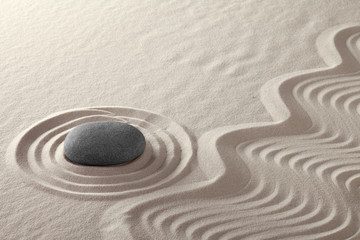
JT: Yeah, there is. I love that you talked about that with meditation too, because research is proving that in meditative states, really what we’re accessing when it comes to creativity and flow is that theta brainwave, right? So there’s the alpha and the alpha-two that the Brain Science Institute in Los Angeles are talking about when it comes to being in a flow state. But theta state is where kids live. You know, kids are in flow. Kids are in a good mood most of the time. If you look at a baby… if you cover a baby’s nose, they’ll start coughing because they naturally breathe through their nose. Children and fetuses breathe through their nose naturally. It’s only as adults, we start learning that we can save a little bit of energy. We can make it longer by white-knuckling throughout the day. And typically that comes from breathing only through our mouth.
Brian MacKenzie—The Art of Breath and the State: Breathing app—calls it mouth-breathers. We’re walking around with our mouths open all the time and we’re mouth-breathers. But we’re not designed for this. And I think when you talked about meditation and playing around with breathwork there, you were actually probably being guided by your physiology. You were noticing that when you took certain breaths in for longer or had certain cycles of breath, that it induced that theta state, more that flow state. And that’s really what meditation is about. It’s about being with the breath.
I’ll never forget—for the people that are doing yoga in your audience, or just for anyone that’s more curious about breathwork and meditation—when I did a 10-day Vipassana. And 10-day Vipassana is literally, you don’t look at anyone, you can’t masturbate, you can’t work out. You can’t do any of the things. No caffeine, none of the vices that we all have in America. What happened was, over those 10 days–
DrMR: You can’t talk either, isn’t that–
JT: You can’t talk either, you can’t even look at people. It’s basically like sensory deprivation for your soul. You’re not in a float tank, but all you’re doing is meditating. Meditating 12 hours a day sometimes. So I’ll never forget this. By the sixth or seventh day, I was starting to visualize this triangle around my nose. And I went an entire day by doing only nostril inhales and slow exhales through my mouth. And I started to feel emotions come up in my body—this is early 2016—and the emotions were, like, sadness, tension, fear, and anger. All these things that I honestly didn’t even know were there.

And the reality is, we don’t need to know where these things come from. All we need to know is how to get them out. Knowing is totally different than the process of healing. Like, does it matter if something happened or why it happened? We are where we are now. So when I look at the epidemic of stress in America, I see why breathwork is on the rise, why even certain plant medicines or alternative therapies are on the rise. It’s because we’re more stressed than ever. And we’re all trying to figure out, how do we mitigate this crazy amount of stress that we feel in our country and in the world?
DrMR: Yeah. And that’s a great point. I like the underlying point that one of the main utilities, perhaps, that is garnered by meditation is the control of the breath. And of course, one of the first things I think any guided meditation recommends you do is deep breaths.
Benefits of Breathwork
So where do you want to launch into this conversation? Maybe we can start—just for the people in our audience who are science buffs—you shot me a study about how rhythm of breathing affects memory and fear. I believe that was actually the title of this study.
JT: Yes.
DrMR: There was some pretty eloquent scientific documentation that the way you breathe can affect your brain, your memory, and your fear. And who doesn’t want to have a better memory?
And there are other research studies that have shown that being more anxious or depressed does negatively impact what’s known as working memory, which is the amount of stuff you can keep in your head at one time. And the more stuff you can keep in your head, the more connections you can make, the more effective you’re going to be in problem-solving and creative thinking, what have you. So tell us a little more about this study that you just pinged me on.
JT: Yeah, I love this study. I actually just found it. It’s a couple of years old. But it’s funny, whenever I’m looking for something, I tend to find the gems, and those gems have been out there for a few years. If anyone does research and looks into the power of breathwork, breathwork is an ancient technology that modern science is starting to understand can be efficacious towards healing the body, even digestive issues, with specific diaphragmatic breathing.

In this study from Northwestern University though, they’re really linking how breathing is not just for oxygen. We all know we need oxygen. But now they’re linking specific breath to brain function and behavior. The scientists discovered, for the very first time, that the rhythm of breathing creates this electrical activity in the human brain that enhances emotional judgments and memory recall. So really what they found is, whether you inhale or exhale, and whether you breathe through your nose or your mouth, this is the key differentiator.
When their subjects were having their breath monitored—the amount of oxygen and carbon dioxide coming in and out—they also had electrodes on their brain to measure that fear response in the amygdala. They found there was a dramatic difference in brain activity in the amygdala and in the hippocampus during the inhalation phase compared with the exhalation phase. When you breathe in, they were discovering that you’re stimulating the neurons and the olfactory cortex, the amygdala, the hippocampus. And it was that ability for them to breathe in through the nose that made them more acutely aware of their environment.
What happens is, most of us breathe through our mouth. We have these spiral dynamics, the structure in our sinuses, and I know this because I just got over sinus surgery and I couldn’t breathe for like a month. It was crazy. I was feeling so stressed out, as somebody who loves breathwork. And it’s a corollary to this study they did at Northwestern. When people were able to breathe in through their nose and out through their mouth, they were able to be more acutely aware of how they could manage stress in their environment, and they actually had better memory.
They did the same test in a corollary and they found that people who weren’t breathing through their nose had poor memory recall. This is fascinating to all of us, because the reality is, we’re designed to breathe in through our nose and out through our mouth. And some people even believe, if you look at MacKenzie’s work, that breathing in and out of your nose is actually the way to go. This is the whole beautiful exploration of science and physiology.

But at the bottom line, this study proves that people who are using their nose and their mouth properly—how it was designed, going back to how we breathed when we were kids and fetuses—actually promote that natural cognitive function when it comes to fear response. And of course, that transfers into our ability to handle stress. So this is really fascinating to me. I think we’re scratching the surface on breathwork. I think we’re going to continue to see it rise in efficacy for stress and also for anxiety.
Starter Techniques in Breathwork
DrMR: So if someone’s meditating, I’m assuming they’re doing a halfway decent job with breathing. I don’t want to assume too much, but I think that’s a fairly safe assumption to make. What I’m hoping to do chiefly is capture the people who haven’t really been able to get very far with meditation.
If we can give them some techniques for breathwork, they now have something to focus on. They don’t have to worry about sitting there, clearing their mind, and being annoyed by the fact that every time they try to do that, their mind thinks about what they have to buy at the grocery store and whatever else. So what are some techniques that people can start using to capture the benefits from breathwork?
JT: This is an awesome question. And the timing of this is unique because I just sent out a newsletter about breathwork. We’re going to do an event here in a couple of months. Thích Nhất Hạnh, a very famous philosopher and somebody who I believe is at the end of his life, has a quote that relates exactly what you just said. He said, “Feelings come and go like clouds in a windy sky. Conscious breathing is my anchor.”
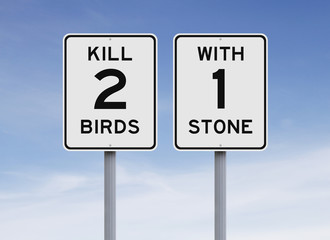
And really how this applies to meditation is, we all deserve an anchor for the monkey mind. If you start your day, jump out of bed, go right to the coffee, don’t hydrate, check your phone as you slide out of bed, you’re literally just sending yourself to an emotional dump truck. There’s nowhere for you to go. This anchor that Thích Nhất Hạnh was talking about is our breath. So it starts for me, Michael, before I even meditate. I meditate in the mornings on a stool. And I actually do it naked in front of a Joovv light, so your audience might enjoy that. I kill two birds with one stone. For people that are just beginning, take three deep breaths before you even get out of bed. That is the starting point to cue your nervous system. Your breathing, your respiration, and your HRV have all been figuring themselves out as you sleep, especially in that last window of sleep, the two hours before we wake up.
So if you can cue yourself with a closed mouth, take a massive belly breath in through your nose. Take three belly breaths in through your nose and slowly out through your mouth. You’ll feel your lungs stretch. You’ll feel your diaphragm open. Then get out of bed, hydrate with lemon water, go to your meditation place. That’s the prep. And I had to reframe your question because, I think, just sitting down to meditate when someone’s already in a hurry, they’re going to spend the first five to 10 minutes just forgetting they were in a hurry. And then they’re going to wonder why the meditation didn’t work. So that’s the prep for it.
Once they actually sit down though, this is really key. There are some biomechanics involved. The crease of the hip. So we want to have the knees an inch to two inches below the hip flexor. And how that’s going to work is whether you’re in Lotus position or cross-legged—Criss-Cross-applesauce, or whether you’re seated on some kind of pad—if your knees are above your hips and your spine is actually slouched forward, you’re not going to be able to open up your diaphragm and your lungs are going to be closed. So again, one to two inches with your knees below your hips, preferably mounted on some type of pad or maybe–
DrMR: Oh, is that one of the main reasons why people sit on little pads?
JT: Exactly.
DrMR: I was sitting on the floor saying, “Oh, I can do it. I can be flexible enough like everybody who’s really flexible.” But I’m going to actually buy a little stool or pad now, because my knees are definitely above my hips when I sit.
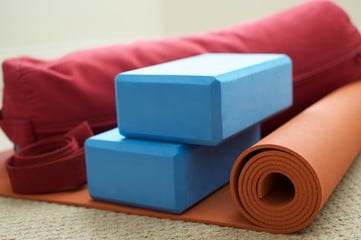
JT: I love just a simple yoga bolster. You can get it on Amazon. It’s like 30-40 bucks. Or you can get a meditation cushion or stool. Just keep it easy. The key is though that you want to feel like you’re on something firm, so sit literally on your coccyx. Make sure that your shoulders and your head and your spine are completely straight. So you want to stack your head, shoulders right over your hips.
What happens with most people is they lean forward. Because all of us are in a forward flex society. So a lot of people are slouching forward, as you know with your chiropractic. That’s typically all Americans, the kyphotic forward-flexed posture. So pull your shoulders back, put your hands directly on top of your legs, or place your hands in a comfortable position. And before you start your breathing, your meditation, just sit there and notice where you feel comfortable and uncomfortable. Do that first. This is after you’ve done the three breaths in the bed.
Then, once you’re in that position, this is the coolest part. When you’re in that position, first just take a deep breath, just clear the palate. So take a big inhale through your nose and then breathe out through your mouth. I find that by doing that one deep breath with your body seated—whatever was going on beforehand, if you’re worried about your phone or your day or all these distractions—with the spine stacked, and your knees below your hips, actually takes care of the monkey mind for most people.
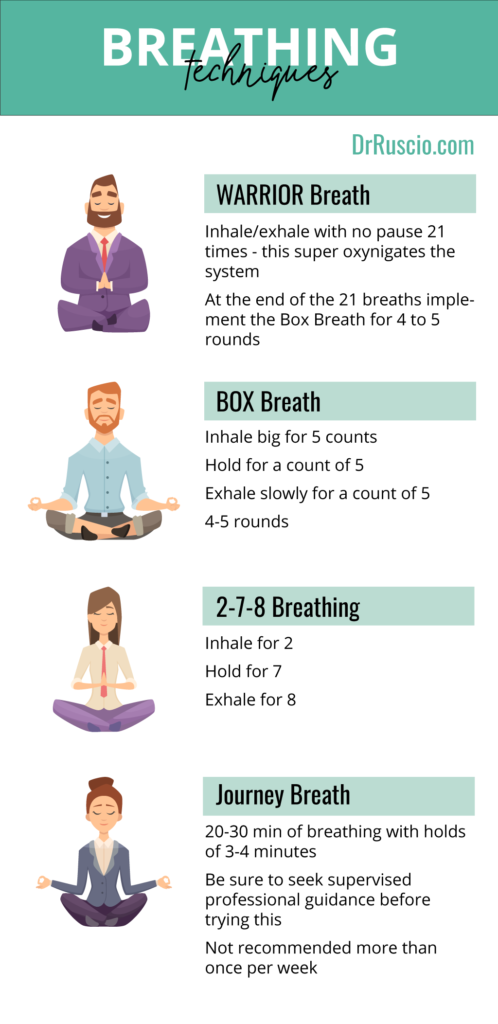
Now, for the aggressive monkey mind, for the people that have a lot of stress, what I like to do is what’s called a warrior breathing cycle. You’re in that seated position with the posture we talked about. You do the warrior breathing and it’s literally just inhale, exhale, with no pause. You do 21 of those. What that does is it super-oxygenates the system. So you’re going inhale, exhale, quickly.
Then at the end of those 21, you’re going to inhale for five and implement what’s called a box breath. When you’re doing those 21 quick warrior breaths, at about 10 or 15 you’re not going to be thinking about anything else. All you’re going to be thinking about is the cue of the breathing that’s in your body. And this is the coolest part of breathwork. It gets people out of their heads and into their body. By the end of the 21, you’re going to feel more in your body. You’re going to inhale big and hold, pushing your diaphragm out. All breath starts with a diaphragm first and then the lungs come second. And then you’re going to hold it for five at the top. Then after you held it for five, you’re going to exhale slowly for five. And at the bottom you’re going to hold it for five. This is called a box breath. This is what warriors do. This is what Mark Divine teaches his SEALFIT Academy to do.
It’s a five count in, five count hold, five count exhale, five count hold, just as if you’re drawing a box. So for the people that have that really, really noisy monkey mind, the 21 warrior breaths with the five, five, five, five, is going to be the best way to start your meditation. If you want to go deeper from there, you can explore doing more cycles. And there are some other different various breath hold practices we can talk about, but that’s the beginning step for people that are like, “I really can’t meditate.” Well, now you can.
DrMR: And so you’re holding on both the end of the exhale and the end of the inhale, for that five?
JT: Yep. Visualize a box. You know, four sides. Inhale hold, exhale hold, each one’s five.
DrMR: That’s great. Yeah, I like that.
Sponsored Resources
DrMR: Hi, everyone. I wanted to thank Intestinal Support Formula, formerly known as Intestinal Repair Formula. We had to change the name because “only a drug can treat a disease or heal your intestines” for making this podcast possible.
Now, Intestinal Support Formula is a must-try if you’ve done everything else for your gut. Why? It addresses the often-overlooked piece of your gut health, your immune system, by binding to and deactivating toxins and irritants like bacterial fragments, thus allowing your gut to heal and breaking the vicious cycle of inflammation and leaky gut.
Think of it like wrapping shards of glass in wax, and deactivating them, and making them no longer irritating. You can learn more about Intestinal Support Formula at intestinalsupportformula.com.
I would also like to thank Platinum LED, which makes perhaps the best red light therapy unit on the market. And the research here, while preliminary, has some encouraging results for an array of applications including: thyroid, skin health, anti-aging, joint pain, muscle recovery and body composition.
In a direct side-by-side comparison, and this is really cool, I’ll put a video showing you this, the Platinum LED Therapy Lights produced the highest irradiance of any LED therapy light on the market today.
All of their lights come with a 60-day trial period, which is great, and a full three year warranty worldwide. Also, when positioned correctly, they admitted to zero EMF. They are now offering $50 off select panels when you visit platinumtherapylights.com and use the coupon code Ruscio50.
I’m just picturing myself as the avatar of doing this. And I like that kind of aggressive breathing. I find that if I can do something to improve my energy a little bit—I don’t know if there’s anything to this—I tend to have better meditations. And I don’t know why that is.
But it would make sense, if you’re in a more energetic state, you can focus more or you can tune in more. That’s what I have sometimes noticed. And I’ve kind of fallen into, like I was describing before, a short term of really deep breathing. That seems to get the juices flowing. Like, literally, sometimes I feel tingling in my body in a good way.
JT: Yeah.
DrMR: And then I can coast into a shallower breathing pattern, which sounds like it somewhat overlaps with this warrior breathing technique.
JT: I think so. And really, since we’re on this topic of warrior breathing, this is just one format. There are probably—if you look online—20 or more different styles of breath. And we don’t have time to go into all of them. But really, if you look at what breathwork is, no matter what modality you choose, these are various super oxygenation pathways with various hypoxic holds, combined with a skilled facilitator and guidance. Those are really the elements of breathwork, right? There’s the inhale, the hold and the exhale. There are the Bandha locks with the energy systems in the body. But everyone’s looking through this same lens of super oxygenation combined with intermittent hypoxia. So that applies to all modalities.
The Value of Hypoxia in Breathwork
DrMR: Yeah. Talk more about the hypoxia, because that’s something I don’t know anything about. And I haven’t actually stumbled my way into trying that. So what’s the utility of doing that?

JT: So the great thing is that when you take yourself to hypoxia, where there’s less of an oxygen presence (super oxygenation is like that inhale, exhale, so we’re super-oxygenating the system), it tends to have an effect where it presses, almost like when you do a hot and cold therapy. When you’re cold, the blood will shunt to the internal organs and then when you’re warm, the blood will return back to the skin. This is what happens in hypoxia. You’re pressurizing the entire system, you’re holding, your blood pressure increases. It increases circulation. And then when you go back to your breathing, it then allows circulation to flow. So it’s very similar except instead of it being a temperature coefficient, it’s a breathing coefficient that increases and decreases circulation in the body. So the hypoxia element is with less presence of oxygen.
DrMR: It’s interesting that you say that. I’ve been using this breathing technique, which is essentially nasal-only breathing during cardiovascular training. And there was recently even someone on Joe Rogan talking about this. Mike Nelson, who’s been doing my programming, has informed me that there is something about nasal-only cardiovascular training—so if I’m rowing or running, only breathing through my nose—that actually helps expand your cardiovascular capacity. And I think it’s because it actually allows a bit more buildup of CO2 and a bit less influx of oxygen, so it makes your body more efficient. I guess this would be what’s known as your arterial venous efficiency or the amount of oxygen you can extract from your blood.
There does seem to be something about this. It’s a little bit different, but it’s giving the system a little bit less oxygen. But being able to operate efficiently with less oxygen would lead to an adaptation that would make your body more able to extract oxygen from your blood.

JT: This makes sense. I’ll link another study from PubMed, and it’s called “Effects of Nasal or Oral Breathing on Anaerobic Power Output and Metabolic Responses.” So what they proved in here, basically, is nose versus mouth. They had greater anaerobic capacity and metabolism activation through doing this cued nostril breathing. And this is fascinating to me. I hate to go so simplistic here, I don’t want to be reductionistic. What I want to say is, the clues are typically found in nature. We tend to complicate things. And you and I have talked about this in person. People are wondering, “Should we breathe through our nose? Should we not? Wait a minute, you’re telling me that I should breathe through my nose for greater anaerobic capacity?”
Look at children. Look at how we come into the world, the first seven years of our life. From a gut perspective, from an emotional perspective, from a breathing perspective. If we just study how children and adolescents learn and adapt to this world, we can apply those same lessons to being healthy adults. And I think the research is catching up to this.
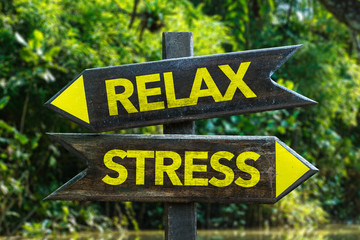
It’s fascinating to me. If you look at the work of Brian McKenzie, The Art of Breath and his State App, you can see the videos on YouTube where he’s using athletes doing pullups and doing this conditioning with balloons in their mouths. This is really cool. The reason why he’s doing this is because he wants people to see how much they’re breathing through their mouth versus how much they’re actually cueing themselves to breathe through their nose. Some of the people can go an entire workout and the balloon only fills up a tiny bit. Some of the people’s balloons pop. So it’s a great way of training to show how much you’re breathing through your mouth versus your nose. And honestly how much the data of your workout is being affected.
So this is a fascinating wing of exercise science. The exercise science is not my expertise, I just have a lot of respect for it. For me, I’ve just cued myself over the past three, four years really on the stress reduction side, but they’re both fascinating.
Three Recommended Modes of Breathwork
DrMR: Are there some other techniques that you really like for breathwork? Any others that you found to be helpful maybe to get someone out of a funk, or whatever else you like?
JT: Yeah, there are three modes that I do. The first one is just daily practice. And for me, the daily practice is this 21 warrior breath with the five, five, five. That’s what I tend to do almost every single morning.
Then there is more breath awareness. There’s a breath practice where, if you’re acutely nervous—so let’s say you’re about to go on a stage or you’re about to do a lecture and you’re feeling your heart beating fast—there’s a way to get out of nervousness. It’s the two-seven-eight model. What we do with the two-seven-eight is, a quick inhale through the nose activates the stress system. So that’s sympathetic. When we hold for seven with the diaphragm full, that’s actually pushing on the vagal tone. And as you know, Mike, we’ve done so many shows on Wellness Force where we talked about the enteric nervous system, there’s so much going on down there in the gut area. And that vagus nerve is one of those things that goes down there. When the diaphragm pushes on the vagus nerve and holds for seven seconds, it allows the body to be calm in the presence of not breathing. So the space between breathing is where you’re training the mind and the nervous system to be calm. And then that slow eight-second exhale, that’s where you’re really getting the rest and digest.

So the quick two, the hold for seven and then the slow eight. This is almost performance breathing for a public speaker or somebody that’s going to do a lecture or something like that. So I really love the two-seven-eight if I’m nervous about something or if I’m feeling like, “Hmm, there’s a monkey mind going on right now and I can’t shut it off.” I don’t have time to meditate, but I’m just going to do four to five rounds of this two-seven-eight style. And that’s a really big one.
And then, the last category is the journey breathwork. The journey breathwork is the Stan Grof, the Wim Hof, even people having psychedelic experiences literally going out of their body through breathwork. Like I said, all breathwork is through that same lens of super-oxygenation with the hypoxia. And I’ve done Wim Hof, I’ve done SOMA breathwork, I’ve done holotropic, I’ve done rebirthing, I did transformational breath when I was at Rythmia. So out of all of these, what I felt is, they typically start with a rolling breath. This is that third category, the journey of breathing. Once people have mastered the daily practice, then the stress reduction, then going onto the journey breathing, this is where you’re going to breathe for 20 to 30 minutes. So literally inhale, exhale with no pause, just rolling breathing. And this is actually the Wim Hof method, right? The Wim Hof method is where people go through this rolling breathing and then there’s a long hold, a three or a four minute hold.
This journey breathing is not for everyone. By the way, I’m not saying that anyone should jump right into the journey breathing. Because when you go on that deep of an experience, it’s a good idea to get a health evaluation or just make sure medically that you’re cleared to do something like that. The first two phases I think anyone can do. But that journey breathing is really for the warrior. It’s for somebody that wants an emotional catharsis. It’s for somebody that wants a deeper healing.

Bruce Lipton might mention in his work, the issues are in the tissues. We’re learning more and more and more about everything that’s going on from the tissue perspective and things possibly being stored from the efferent and afferent connection with the brain. So this journey one, it’s fascinating. I love it. I’ve had multiple times where I’ve cried during breathwork and I didn’t know why I was crying. It just came out. And to me, the biggest report card is how I feel. If I can use any of these three modes of breathwork and I feel like I’m going in the right direction in my life, I don’t really need the science to tell me, you know? Sometimes just anecdotal is the best way to go anyways.
DrMR: Sure, I agree with you. And certainly, we haven’t studied everything scientifically. So it’s one thing if there’s science disproving a concept, but if there’s really no science looking at something at all, then I revert to a pretty open mind, as long as it’s reasonable.
JT: Yeah.
DrMR: So you’re doing a three to four minute hold. That’s a decent hold. And how often are you doing that in this 20 to 30 minute total breathing cycle?
JT: Personally, this is my own vantage point from doing this for awhile. I don’t like to do more than one of those a week. Because if you think about it, you’re going into a state of deep hypoxia and deep super oxygenation. And there are also some cues where you pull in your abdomen and your perineum. They’re called “Bandha locks” from yoga. Uddiyana-Bandha. When you do that, you go very deep emotionally and also your physiology is taxed.
So the first time somebody does a CrossFit workout, they wouldn’t want to do like 300 squats and 300 pull ups. But I think when it comes to breathing, people think it’s so easy. And it’s really not because there’s a lot of presence that’s involved. There’s a lot of load to the physiology and it takes a strong mind. It takes somebody who is desiring personal growth. They’re in the process of letting something go. And by the way, they might not even know what’s bothering them.
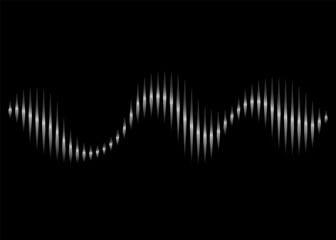
A lot of times when people do these deep journeys… I witnessed this specifically at Rythmia, there’d be people crying, there’d be people screaming, there’d be people processing demons from their body (like, emotional demons, whether or not you believe in demons). They’re processing a stored emotion. So I would not recommend that people do this more than once a week, unless they’ve titrated up, unless they’re able through a progressive practice to get there. Because the danger is, if you start doing all this breathing and it’s unsupervised, or you’re with somebody who’s not accredited, you could really tax your nervous system and your physiology. And of course we never want to do that.
DrMR: Sure. And yeah, burn yourself out.
JT: Yeah, don’t want to burn out. It’s such a load on the body.
DrMR: Yeah, and a three minute breath hold… that’s no joke.
JT: It is no joke.
DrMR: I have held my breath for three minutes and it’s not easy. I wouldn’t think most people could do that without a significant working up to it. So someone’s going to do, let’s say, this journey breathing for 20 minutes. How often in that 20 minutes are they doing the three minute hold?
JT: This depends on the facilitator. There are many different styles, right? Let’s go to the Wim Hof. In the breath retention phase—where you hold your breath out for as long as possible—they also have times where you hold it in for 15 and 20 seconds. Many of the scientifically proven health benefits of the Wim Hof method are that they’re doing like 20 to 30 cycles of continuous connected breathwork. Again, from where I see it and where I stand in the research that I’ve read, when we go through this continuous breathing and we get to that super oxygenation, it’s the hypoxia where we’re actually doing the hard work.

When we’re in hypoxia and our body is still, we’re not breathing, it’s complete silence. This is where the monkey mind likes to flare up for most people. So it’s actually the training of breathwork in the hypoxia—in the stillness, in the complete and total quiet—that’s where we sit and are the observer. We’re watching, like, “Okay, I’m safe. I’m in my body, everything’s fine. Let me check in and see if I really do have to breathe or if this is just my mind telling me to breathe because it doesn’t like the stillness.” And this is where most people find the challenge in breathwork, in the hypoxic hold.
DrMR: Yeah. That’s something I’m probably going to try today.
Seven-Day Breathwork Guide
JT: Yeah, we can do it the next time we see each other too. And there are so many resources out there. I have a seven-day breathwork guide that I would love to give to your audience as well. It can walk people through just that first preliminary, the 21 warrior breaths and the five count pause.
DrMR: Please, yeah, that’d be great, because there are a few clarifying details I did want to ask about that. But I’ll come back to those in just one second. What is the resource that we could point people to there?
JT: The resource is wellnessforce.com/m21. (That’s morning 21.) Just like you, we get to interview these amazing people. So what I do is distill all the wisdom from them. I broke it down to six practices that I researched, science-based practices. One of them is breathwork. And these six practices are literally the best way to start your day. Whether you want to say you’re going to have more energy or higher vibration, however you want to describe it, breathwork is one of these practices.
So in there, there is a seven-day guided breathwork, where I actually guide you through how to do it. Then you just duplicate that every single day for seven days. And we’ve been getting a lot of great messages, people that are doing this breathwork are saying, “I didn’t actually know my body could do that.” They’re so excited with their ability to, again, pull that only autonomic lever that we have control over.
Breathwork & Fitness
DrMR: Awesome. A bit off topic, but do you know of any research that has shown that this hypoxic training, this breath holding training, can improve anyone’s fitness? Like, maybe they have better cardiovascular performance? Their time to run a mile might increase, or anything performance-based has been shown to be facilitated?
JT: Well, one thing I do know—and I can send this study as well—there was a study in 2014 for Yale School of Medicine. They found that the epinephrine surge of doing this specific breathwork causes the innate immune system to increase anti-inflammatory activity. So it dampens pro-inflammatory activity. So the subjects in this study were taught a breathwork routine, and actually had less severe inflammatory responses to bacterial toxins than those who didn’t.

So this paper was, like, the first science literature paper to ever describe this voluntary activation of the innate immune system. So for me, if Yale School of Medicine is doing an antiinflammatory effect combined with breathwork, then I know it’s something that the rest of science is looking at for athletic performance. I think Brian MacKenzie is a really, really great guy to go to for that research. Obviously, if something has an antiinflammatory effect, that’s going to lead to better recovery times, which then would lead to greater workouts in the future.
Breathwork for Cognition & Presence
DrMR: Sure, it’s very interesting. And I’m really hoping that this conversation will capture the type A people who just can’t get into a groove of meditation. Especially if you’re getting these kinds of epinephrine spikes, which are just going to manifest as, “Wow, I feel energized and I feel great,” I’m hoping that this will be a way we can get that type of person to really adopt a practice.
JT: Yeah, me too. Because, look, if anybody gets one thing out of this conversation… my entire life I have always felt like something was coming to get me. And if that hit you, if you have felt like that too, or if you’ve had phases of your life where you felt like that, I just wish, Michael, somebody would have taught me breathing. If I could’ve had breathing as a teenager in high school, or as an athlete, or even in my twenties, I could have made things a lot easier for myself.
I’ll share this. When I’m consciously breathing, then I can show up with my needle in my nervous system tilted over to rest and digest. If I can approach my conversations, my work, whatever it is, with that needle tilted to parasympathetic, then, guess what? I’m going to show up more me. I’m going to be more authentic. I’m going to be more present.
And whether it’s science or spirituality, we all get to be more present. We live in a world right now where there are so many distractions and we’re so pulled left and right. You know this. You’re an entrepreneur. Many people listening to your show are working professionals, we all can kind of feel that this is the busiest and most full we’ve ever been.
DrMR: Yes and I just want to underscore something there really quick. Even if you’re someone who doesn’t gravitate toward the type of language which is more present… I’ll say it, the same thing, but describe it another way.
You can be more cognitively effective. We do know that the more stressed someone is, the poorer their decision making and the poorer their cognition is. So if you’re only in the game for optimization, then this is another way to optimize you. So instead of being present, you’ll be more focused, you’ll be more attentive, you’ll make better decisions.

And I’ve clearly seen this, as I’ve taken that little bit of space to develop a meditation and breathing practice. I do feel like my mental capacity and my decision-making is just a bit sharper. And that makes a big difference in decisions, day after day, week after week, month after month. Those really do start to add up, and in my view, significantly impact the trajectory of what you’re going to be able to achieve.
JT: That’s so true, because whether you’re an analytical person that wants to know the hard science, or you’re just like, “Hey Josh, I just want to feel better, I just want to feel good,” they both have applications. I love the way you did that, because, man, we’re always trying to meet each other with the language of where we are.
So again, if you’re in medical school or if you’re somebody that’s like, “What’s up with this breathing?” I challenge you to dig into the research and actually try it. I think people get stuck in gathering research and they don’t apply, Michael. Like, they’ll gather research, they’ll have their Google Doc spreadsheet with all their PubMed studies, but they never actually try it themselves.
And then of course, the last phase of real intelligence is embodiment. It’s somebody who’s gathered the information, they’ve applied the information and then lastly, they’re a living, walking example of that. They are embodying the lessons and the gathering that they’ve done. I think that’s true intelligence.
That’s why you’ve been on Wellness Force so many times, because you’re an embodiment of your message, right? People go to you to gather, people go to you so that you can actually help them apply. And also with your own physiology, you’re a walking message of what you’re up to. So this is what we’re all on the path to, those three elements of intelligence. And we all just get to help each other do it.
DrMR: It’s incredibly well said. Some of the most eye-opening experiences I’ve had are just applying things. It’s so important to apply things.

I’ve recently shared on the podcast that, even though I think the bulk of the research leans a little bit in the direction that a lowering of carbohydrate in the diet might be the best way to facilitate weight loss, it’s not the only approach. So I’ve always known that, but when I recently increased my carb intake, but was more mindful of my total caloric intake while increasing my carbs, I lost a significant amount of body fat.
I was cognitively aware of that, but to go through it experientially made me even more confident that we don’t have to always be vilifying carbs. Now, there’s a ceiling there where we’re not talking about carbs indiscriminately, they have to be healthy carbs. But certainly, that brought me to another level of appreciation of that position I had been touting for years now.
JT: And it changes as we age, doesn’t it? The man that I was at 21 is not who I am at 39. What worked before we can’t stand on anymore. So there’s this constant evolution of what the research says is “good for everyone” versus what I apply that I find out is good for me.
View Dr. Ruscio’s Additional Resources
DrMR: Absolutely agreed. Just really quick, Josh, I want to touch back on the warrior breathing, because I actually want to try this at some point this week. So I want to make sure I’m clear. It’s 21 breaths, somewhat deep in through the nose, out through the mouth. And you’re doing a period of the five box, right? In for five, hold for five, out for five, hold for five. But how long are you doing that box breathing?
JT: I do that box breathing a minimum of four to five rounds. By the way, the whole reason I do this is so I can have a better meditation. So this is a prep for my meditation. Remember this is just the daily breathwork. There’s the secondary and the third.

So in this specific one, I’ll do four to five rounds. And if I still feel like I’m in my monkey mind or I need to get more physically into my body, I need to feel sensation in my body and I want to turn off my mind, I’ll do the 21 again. I’ll do a second round of that inhale, exhale, no hold. Then I’ll do another four to five of the box. You go through two rounds of that and you’re definitely going to be in your body, more cognitively aware as you had mentioned, or present.
Episode Wrap-Up
DrMR: Awesome. Love it. And I don’t want to describe it as an app or a program, but you’ve got an offering to make this more accessible for people. So where do you want to point people to give them that link again, the Wellness Force link? And then your breathwork offering that you have, and anywhere else you want to point people.
JT: Yeah, this is really exciting for me. It’s been four years of study and experience. And I truly feel like now I’m in that embodiment phase where I’m still learning. I’m still gathering, applying, but I’ve taken all these different experiences that I’ve had from the three phases, and I’ve put them into an offering and this is a group offering. You can go for free.
It’s breathwork.io (and io means in out, which I thought was really cool). And on that site you’re going to find a guided journey. It’s going to give you all the different trainings you need for these three categories that we’ve talked about, so you’ll be fully guided there. If you want to go deeper and if you want to have someone actually walk you through the process with accountability, then there’s going to be an option for you to go more into the programs that we have there. You can get those three categories fulfilled. You can be completely guided through those.
And again, if you’re starting right now and you just want to get a pdf and you want to have an ebook to go through, there is wellnessforce.com/m21. That’s where you can get the seven day guided, that practice that Michael and I talked about.
DrMR: Awesome. And I’ll really encourage people to check out these resources. I finally got over the hump of being consistent with meditation when I used a meditation app. I just needed something that took it from “Go meditate,” (super vague, super open-ended, and I didn’t have the chunking effect). They say, “How do you eat an elephant?” One bite at a time, one chunk at a time.
JT: Yeah.
DrMR: So for me, I use an app where, once per day, I do a 10 minute meditation. My goal-oriented mind said, “Okay, boom, 10 minutes a day, I can do that. Initiate, execute, and then move on.” So I was able to do it. I think having a program where you can just not have to think about anything else but saying, “Okay, I’m just going to plug into the program, do it for however long I have to do it in that given session, and then I’m done,” makes it much easier to actually do this effectively.
JT: I agree with you, man. And honestly, doing anything where you’re in a guided experience compared to just, “Hey, here’s a pdf recording and do it on your own.” That’s great. Some people, their personality, will go for it. But most of us do really well with external frameworks for accountability.
So that’s really what we’re talking about. We’re neurologically wired to be in tribe. Allow yourself to be in tribe, and do programs and things like this with other people, guided.
DrMR: Yup. Love it. Well, Josh, thanks so much for taking the time to chat with us. It was a great conversation, as I knew it would be.
JT: Thank you for having me, man, and I so appreciate you. Just a huge honor to be on your show, so thanks for having me on.
DrMR: Awesome. It’s been a pleasure, buddy. Any time.
Dr. Michael Ruscio is a DC, natural health provider, researcher, and clinician. He serves as an Adjunct Professor at the University of Bridgeport and has published numerous papers in scientific journals as well as the book Healthy Gut, Healthy You. He also founded the Ruscio Institute of Functional Health, where he helps patients with a wide range of GI conditions and serves as the Head of Research.➕ Resources & Links
- meditation pillow or cushion
- Rhythm of Breathing Affects Memory and Fear
- Effects of Nasal or Oral Breathing on Anaerobic Power Output and Metabolic Responses
- 7-day breathwork guide – wellnessforce.com/m21
- Breathwork.io – guided journey
- Intestinal Support Formula by Functional Medicine Formulations
- Platinum LED
- Dr. Ruscio Resources




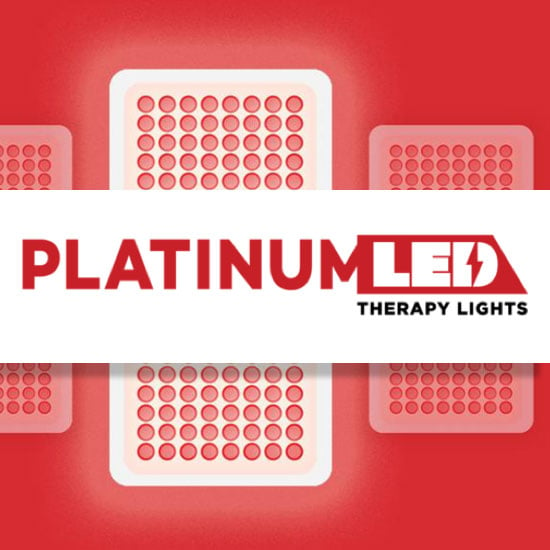

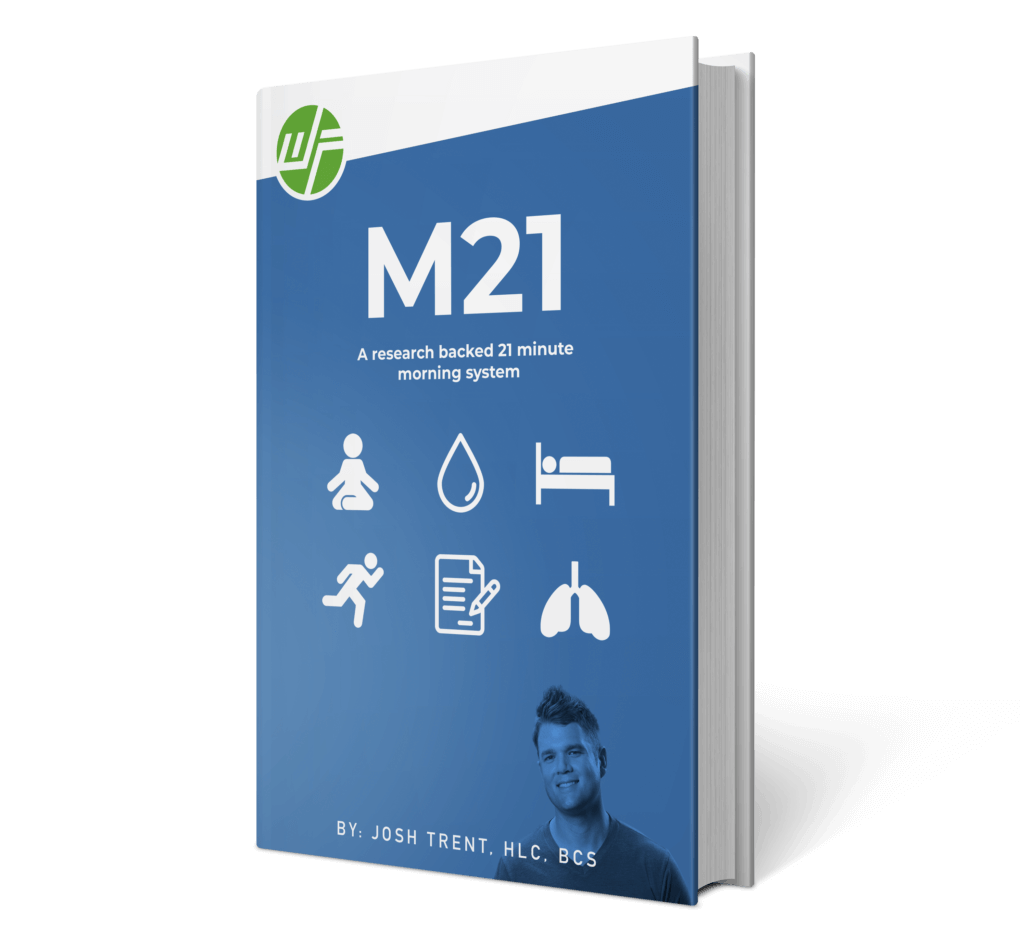
Discussion
I care about answering your questions and sharing my knowledge with you. Leave a comment or connect with me on social media asking any health question you may have and I just might incorporate it into our next listener questions podcast episode just for you!